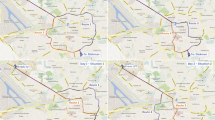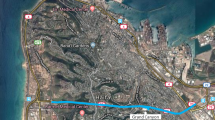Abstract
Travel time is the main factor affecting individuals’ travel-related decisions. Understanding the way people experience and estimate travel time is critical for a better insight regarding travel behavior and consequently for planning transport projects and guiding new policies. Whereas most travel-demand models employ objective time data, the use of subjective time data was proposed to improve model estimation. This study draws on fundamental as well as on recent psychological theories, investigating the discrepancy between subjective and objective travel times. According to one of these theories, the return trip effect, travelers tend to report shorter travel times for return trips compared to outbound trips. In a questionnaire, 174 respondents provided pre-trip time estimates. One group estimated travel times from home to local shopping areas, whereas a second group estimated times of the reverse trips. For comparison, objective times were obtained from Waze, a navigation application providing real-time information. Whereas 48% of time estimates were found accurate, over-estimates were 2.5 times more frequent than under-estimates. A return trip effect was found only for trips to/from poorly familiar shopping areas, highlighting the role of destination familiarity. Interestingly, respondents accurately estimated toll-trips but over-estimated non-toll trips. Presumably, merely thinking about paying the toll led individuals to form expectations of travel time savings in exchange. Linear and non-linear regression models for predicting subjective estimates revealed significant effects for trip frequency, trip direction, destination familiarity, toll-road and gender, amongst other variables. The results offer a fertile basis for incorporating subjective time in demand models.




Similar content being viewed by others
Notes
Some of the studies reviewed above regarding the deviation from objective time were conducted in a time before technical advances allowed for the gathering of more reliable objective time data (e.g., using GPS trackers, license plate detectors). In Henley et al. (1981), for instance, research assistants replicated respondents’ car trips, timing them the following working day. Similarly, Clark (1982) used objective times gathered by research assistants who replicated respondents’ trips twice and then averaged their timings. Rietveld et al. (1999), on the other hand, employed route planners and various proxies.
The Carmel Tunnels (also known as Route 23) cross Haifa from east to west.
One of the anonymous reviewers of this paper has raised a reasonable concern that the students in our sample may have estimated travel time differently compared to the other respondents, given their lower socio-economic level. Yet, we found that 85% of these students indicated that they regularly use a private car. Indeed, a repetition of the main analyses, separately for students and other adults, found no significant differences between their travel time estimates.
In general, the trips investigated in this study were short urban trips, highly typical in Haifa, which is not a large city (approximately 280,000 residents). Therefore, although the boundary of ±2 min is somewhat arbitrary, it is a reasonable boundary for denoting accurate versus inaccurate estimation as mean trip duration was 11.85 min (standard deviation was 5.00 min). Denoting an accurate estimation as one that is within 10% of objective time has shown highly similar results to those presented here.
Given that the heterogeneity model was performed by the maximum likelihood method, R2 data is unavailable.
References
Adiv, A.: Commuter’s versus analyst’s perception of automobile travel cost. Transp. Res. Rec. 890, 18–24 (1982)
Abou-Zeid, M., Ben-Akiva, M.: Well-being and activity-based models. Transportation 39(6), 1189–1207 (2012). doi:10.1007/s11116-012-9387-8
Ashiabor, S., Baik, H., Trani, A.: Logit models for forecasting nationwide intercity travel demand in the United States. Transp. Res. Rec. 2007(1), 1–12 (2007). doi:10.3141/2007-01
Bar-Gera, H., Toledo, G., & Feldman, I.: Level of service measures of the main roads in Israel—Final report (in Hebrew). Ministry of transport and road safety, Israel (2015)
Ben-Elia, E., Erev, I., Shiftan, Y.: The combined effect of information and experience on drivers’ route-choice behavior. Transportation 35(2), 165–177 (2008). doi:10.1007/s11116-007-9143-7
Ben-Elia, E., Shiftan, Y.: Which road do I take? A learning-based model of route- choice behavior with real-time information. Transp. Res. Part A 44, 249–264 (2010)
Block, R.A., Hancock, P.A., Zakay, D.: Sex differences in duration judgments: a meta-analytic review. Mem. Cognit. 28(8), 1333–1346 (2000). doi:10.3758/BF03211834
Buehler, R., Griffin, D., Ross, M.: Exploring the “planning fallacy”: why people underestimate their task completion times. J. Pers. Soc. Psychol. 67(3), 366–381 (1994). doi:10.1037/0022-3514.67.3.366
Burnett, P.: Time cognition and urban travel behavior. Geogr. Ann. 60(2), 107–115 (1978)
Campbell, J.F.: Selecting routes to minimize urban travel time. Transp. Res. Part B Methodol. 26(4), 261–274 (1992)
Cantillo, V., Heydecker, B., Ortu´zar, J.D.D.: A discrete choice model incorporating thresholds for perception in attribute values. Transp. Res. Part B 40, 807–825 (2006)
Carrion, C., Levinson, D.: Route choice dynamics after a link restoration. Transportation Research Board Annual Meeting. January, (2013)
Cervero, R.: Built environment and mode choice: towards a normative framework. Transp. Res. Part D 7, 265–284 (2002)
Clark, J.E.: Modeling travelers’ perceptions of travel time. Transp. Res. Rec. 890, 7–11 (1982)
Curl, A., Nelson, J.D., Anable, J.: Same question, different answer: a comparison of GIS-based journey time accessibility with self-reported measures from the National Travel Survey in England. Comput. Environ. Urban Syst. 49, 86–97 (2015). doi:10.1016/j.compenvurbsys.2013.10.006
De Maio, M.L., Vitetta, A., Watling, D.: Influence of experience on users’ behaviour: a day-to-day model for route choice updating. Proc. Soc. Behav. Sci. 87, 60–74 (2013). doi:10.1016/j.sbspro.2013.10.594
Devarasetty, P.C., Burris, M., Chao, H.: Comparing perceived and actual travel time savings on freeways with managed lanes. J. Transp. Inst. Transp. Eng. 6(1), 1–13 (2014)
Dziekan, K., Kottenhoff, K.: Dynamic at-stop real-time information displays for public transport: effects on customers. Transp. Res. Part A Policy Pract. 41(6), 489–501 (2007). doi:10.1016/j.tra.2006.11.006
Forsyth, D.K., Burt, C.D.B.: Allocating time to future tasks: the effect of task segmentation on planning fallacy bias. Mem. Cognit. 36(4), 791–798 (2008). doi:10.3758/MC.36.4.791
Fox, J., Daly, A., Patruni, B., & Milthorpe, F.: Extending the Sydney Strategic Model to represent toll road and park-and-ride choices. In: Australasian Transport Research Forum 2011 Proceedings (2011)
Fraisse, P.: Perception and estimation of time. Annu. Rev. Psychol. 35, 1–36 (1984)
Grisolía, J.M., Ortúzar, J.D.D.: Forecasting vs. observed outturn: studying choice in faster inter-island connections. Transp. Res. Part A 44(3), 159–168 (2010). doi:10.1016/j.tra.2009.12.005
Grondin, S.: From physical time to the first and second moments of psychological time. Psychol. Bull. 127(1), 22–44 (2001). doi:10.1037/0033-2909.127.1.22
Grotenhuis, J.W., Wiegmans, B.W., Rietveld, P.: The desired quality of integrated multimodal travel information in public transport: customer needs for time and effort savings. Transp. Policy 14(1), 27–38 (2007). doi:10.1016/j.tranpol.2006.07.001
Gunn, H.: Valuation of travel time savings and loses. In: Hensher, D., Button, K. (eds.) Handbook of Transport Modelling. Elsevier, Oxford (2000)
Halkjelsvik, T., Jørgensen, M.: From origami to software development: a review of studies on judgment-based predictions of performance time. Psychol. Bull. 138(2), 238–271 (2012). doi:10.1037/a0025996
Hammond, K.: Case-based planning: a framework for planning from experience. Cognit. Sci. 14, 385–443 (1990). doi:10.1016/0364-0213(90)90018-R
Henley, D.H., Levin, I.P., Louviere, J.J., Meyer, R.J.: Changes in perceived travel cost and time for the work trip during a period of increasing gasoline costs. Transportation 10(1), 23–34 (1981). doi:10.1007/BF00165615
Hornik, J.: Subjective vs. objective time measures: a note on the perception of time in consumer behavior. J. Consum. Res. 11(1), 615 (1984). doi:10.1086/208998
Jiao, J., Moudon, A.V., Drewnowski, A.: Grocery shopping—How individuals and built environments influence choice of travel mode. Transp. Res. Rec. J. Transp. Res. Board 2230(−1), 85–95 (2011). doi:10.3141/2230-10
Kahneman, D., Tversky, A.: Intuitive prediction: biases and corrective procedures. TIMS Stud. Manag. Sci. 12, 313–327 (1979)
Leavitt, H.J.: A note on some experimental findings about the meanings of price. J. Bus. 27(3), 205–210 (1954)
Mackie, P.J., Wardman, M., Fowkes, A.S., Whelan, G., Nellthorp, J., Bates, J.: Valuation of travel time savings in the UK. Summary report to the Department of Transport, London (2003)
Mishalani, R.G., Mccord, M.M., Wirtz, J.: Passenger wait time perceptions at bus stops: empirical results and impact on evaluating real-time bus arrival information. J. Publ. Transp. 9(2), 89–106 (2006)
Morris, J.M., Dumble, P.L., Wigan, M.R.: Accessibility indicators for transport planning. Transp. Res. Part A General 13(2), 91–109 (1979). doi:10.1016/0191-2607(79)90012-8
Nakayama, S., Kitamura, R., Fujii, S.: Drivers’ learning and network behavior: dynamic analysis of the driver-network system as a complex system. Transp. Res. Rec. J. Transp. Res. Board 1676, 30–36 (1999). doi:10.3141/1676-04
O’Farrell, P., Markham, J.: Commuter perceptions of public transport work journeys. Environ. Plan. A 6(1), 79–100 (1974)
Pappas, E., Machemehl, R.: Predicting the incremental effects on transit ridership due to bus-on-shoulder operations 6. Retrieved from Research Report SWUTC/10/476660-00073-1 (2010)
Peer, S., Knockaert, J., Koster, P., Verhoef, E.: Overreporting vs. overreacting: commuters’ perceptions of travel times. Tinbergen Institute Discussion Paper 13-123/VIII. http://doi.org/http://www.sciencedirect.com/science/journal/09658564 (2014)
Prashker, J.N.: Direct analysis of the perceived importance of attributes of reliability of travel modes in urban travel. Transportation 8(8), 329–346 (1979)
Raghubir, P., Morwitz, V.G., Chakravarti, A.: Spatial categorization and time perception: why does it take less time to get home? J. Consum. Psychol. 21(2), 192–198 (2011). doi:10.1016/j.jcps.2010.08.006
Rao, A.R., Monroe, K.B.: The effect of price, brand name, and store name on buyers’ perceptions of product quality: an integrative review. J. Market. Res. XXVI, 351–357 (1989)
Rietveld, P., Zwart, B., van Wee, B., van den Hoorn, T.: On the relationship between travel time and travel distance of commuters. Ann. Reg. Sci. 33(3), 269–287 (1999). doi:10.1007/s001680050105
Roy, M.M., Christenfeld, N.J.S., McKenzie, C.R.M.: Underestimating the duration of future events: memory incorrectly used or memory bias? Psychol. Bull. 131(5), 738–756 (2005). doi:10.1037/0033-2909.131.5.738
Scholnick, E.K.: Plannning. In: Vilayanur, R. (ed.) Encyclopedia of Human Behavior, pp. 525–534. Academic Press Inc., Cambridge (1994)
Shiftan, Y., Bekhor, S.: Investigating individual’s perceptions of auto travel cost. Int. J. Transp. Econ. XXIX(2), 151–166 (2002)
Shiftan, Y., Shefer, D.: Evaluating the impact of transport projects: lessons for other disciplines. Eval. Progr. Plan. 32(4), 311–314 (2009). doi:10.1016/j.evalprogplan.2009.08.003
Stevens, S.S.: On the psychophysical law. Psychol. Rev. 64(3), 153–181 (1957). doi:10.1126/science.3.71.712-a
Stevens, S.S., Galanter, E.H.: Ratio scales and category scales for a dozen perceptual continua. J. Exp. Psychol. 54(6), 377–411 (1957)
Thomas, K.E., Handley, S.J., Newstead, S.E.: The effects of prior experience on estimating the duration of simple tasks. Cahiers de Psychol. Cognit. 22(1), 83–100 (2004)
Van Exel, N.J.A., Rietveld, P.: Perceptions of public transport travel time and their effect on choice-sets among car drivers. J. Transp. Land Use 2(3), 75–86 (2009). doi:10.5198/jtlu.v2i3.15
Ven, N., Rijswijk, L., Roy, M.M.: The return trip effect: why the return trip often seems to take less time. Psychon. Bull. Rev. 18(5), 827–832 (2011). doi:10.3758/s13423-011-0150-5
Vreeswijk, J., Thomas, T., Van Berkum, E., Van Arem, B.: Perception bias in route choice. Transportation 7451(October), 1–14 (2014). doi:10.1007/s11116-014-9552-3
Vreeswijk, J., Thomas, T., Van Berkum, E., Van Arem, B.: Drivers’ perception of route alternatives as indicator for the indifference band. Transp. Res. Board Travel Behav. 2, 10–17 (2013). doi:10.3141/2383-02
Weick, M., Guinote, A.: How long will it take? Power biases time predictions. J. Exp. Soc. Psychol. 46(4), 595–604 (2010). doi:10.1016/j.jesp.2010.03.005
Yáñez, M.F., Raveau, S., Ortúzar, J.D.D.: Inclusion of latent variables in mixed logit models: modelling and forecasting. Transp. Res. Part A 44(9), 744–753 (2010). doi:10.1016/j.tra.2010.07.007
Yefe Nof: Haifa metropolitan area travel survey 2006, Report. Yefe Nof, Haifa, Israel (2007)
Zakay, D.: The evasive art of subjective time measurement: some methodological dilemmas. In: Block, R.A. (ed.) Cognitive Models of Psychological Time, pp. 59–83. Hillsdale, New Jersey, Lawrence Erlbaum (1990)
Zakay, D., Block, R.A.: Temporal cognition. Curr. Dir. Psychol. Sci. 6(1), 12–16 (1997). doi:10.1111/1467-8721.ep11512604
Zauberman, G., Kim, B.K., Malkoc, S.A., Bettman, J.R.: Discounting time and time discounting: Subjective time perception and intertemporal preferences. J. Mark. Res. 46(4), 543–556 (2009). doi:10.1509/jmkr.46.4.543
Author information
Authors and Affiliations
Corresponding author
Rights and permissions
About this article
Cite this article
Tenenboim, E., Shiftan, Y. Accuracy and bias of subjective travel time estimates. Transportation 45, 945–969 (2018). https://doi.org/10.1007/s11116-016-9757-8
Published:
Issue Date:
DOI: https://doi.org/10.1007/s11116-016-9757-8




